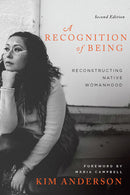Description
A Recognition of Being: Reconstructing Native Womanhood is an examination of how the image and role of Native women has changed as Native women take control over their lives and communities. The author, Kim Anderson, is a Cree/Metis writer and educator. Her thesis and work with a Native women's centre in Toronto challenged her thinking about Native women's issues and concerns. She declares that often analysis of Native women and identity revolves around the historical and changing role of women in Native societies. As a result she proceeded to interview 40 First Nations, Metis, and Inuit women (mainly professional) from across Canada. The list of interviewees includes Jeannette Armstrong, Marlene Brant Castellano, Maria Campbell, Emma LaRocque, Lee Maracle, Edna Manitowabi, and Katie Rich. From these interviews and selective readings of literature by Native authors, the author developed a thesis that utilizes the medicine wheel for understanding. It consists of four main themes û resist, reclaim, construct, and act. The book begins with the author explaining her background and setting the context for the study; describing how to work with tradition and culture; and discussing oral and literary sources. The second section titled Looking Back: The Colonization of Native Womanhood discusses the historical representation of Native women and how colonization radically altered Native societies. The author outlines women's traditional roles in terms of family, politics, economy, and spirituality. These roles based on gender equity changed with the impact of Euro-western religion and government, and the lack of respect from their own communities. The author dismisses the idea of the ôrole of Native womenö by replacing it with the belief that it is a constant exercise in finding a balance between individual identity, family obligations, community and nation, and spiritual context. The remaining sections describe how Native women are reclaiming cultural traditions and recreating positive images of themselves. The final section of the book features a dialogue between the author and her friend and colleague, Bonita Lawrence. The book includes a bibliography, participant list with biographical background, and an index. This is a welcome addition to the growing literature about Native women from the Aboriginal perspective.


